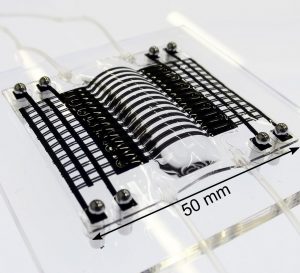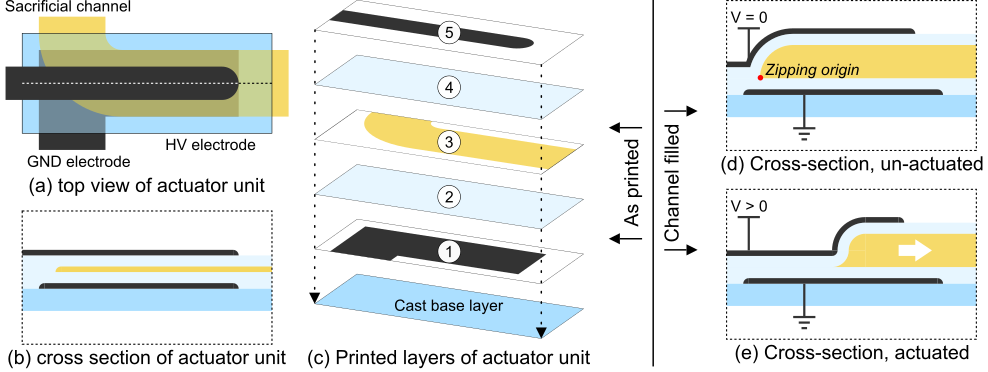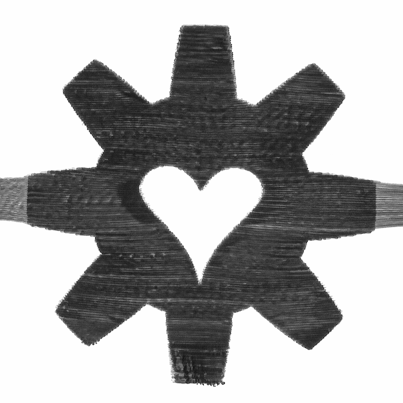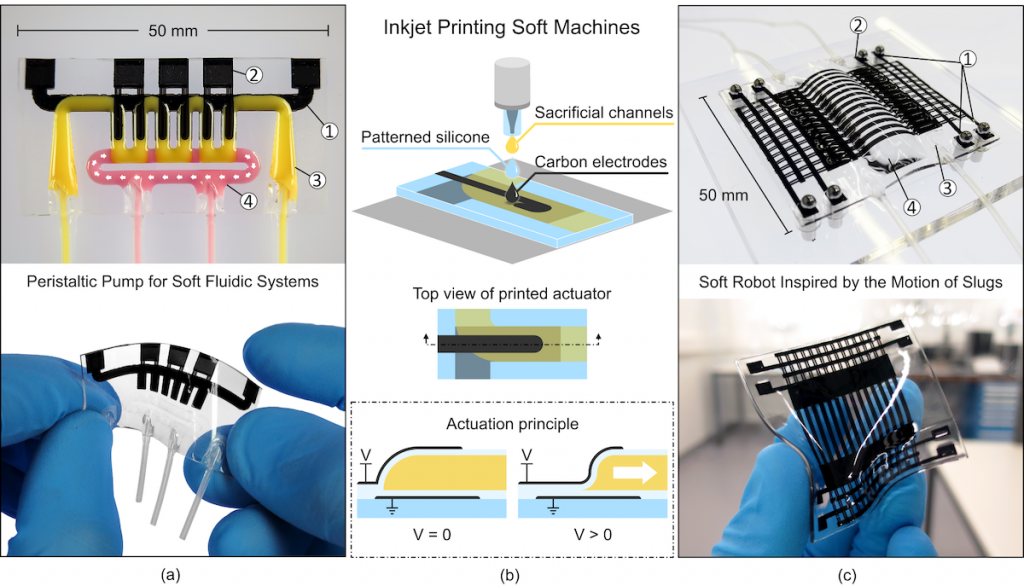We have developed an approach to manufacture soft DEAs and zipping actuators by using drop-on-demand (DOD) inkjet printing. Details in the 2020 Adv. Intell. Sys article (open source)
We use a jetlab® 4 (MicroFab) printer for this work, as it allows tuning many jetting parameters.
1- integrated process printing fully functional soft machines

We developed a multimaterial inkjet printing method for integrated soft multifunctional machines, combining dense arrays of electrostatic actuators, multilayer electrical routing, and complex networks of microfluidic channels in one printing process.

To integrate electrostatic zipping actuators and microfluidics in stretchable soft machines without any rigid components, we developed inks for sacrificial layers, dielectric elastomers, and compliant electrodes, along with a unified printing process to print multilayer structures.
Printed 2.5D stacks are transformed into fully functional 3D soft machines by inflating thin elastomer channels. Two demonstrators are reported, each consisting of seven printed layers: a flexible peristaltic pump and a compliant slug drive, inspired by the locomotion of slugs. The peristaltic pump has six integrated actuators, whereas the slug drive has 28 integrated actuators, generating a travelling wave used to transport objects. T
hese soft devices demonstrate how inkjet printing produces densely packed high‐voltage actuators, including vias for electrical routing. Sensors and logic may be printed in the future to produce more complex autonomous soft machines.
2. Thin Inkjet printed silicone membranes
We identified five two-part Thermal-cure and one UV-cure silicone rubber materials that we could print using a drop-on demand piezoelectric inkjet system.
Using this process, 3D structures and high-quality silicone dielectric elastomer membranes as thin as 2 μm were printed. The printed films exhibit mechanical and DEA actuation performance at least as good as conventionally blade-cast membranes. Printed silicone membranes exhibited maximum tensile strains of up to 727%, and DEAs with printed silicone dielectrics were actuated up to 6.1% area strain
We were able to print the following silicones: Wacker Elastosil® P7670, NuSil MED-4086, NuSil CF18-2186, Bluestar Silbione® LSR 4305, Wacker Silpuran® 6000/05, Wacker Elastosil® LR 3003/03, and Momentive Silopren® UV Electro 225-1.
![]()
EPFL logo inkjet printed in silicone. Vertical scale bar is in µm. In-plane dimensions: 10 mm × 18.4 mm. Consists of a 2 μm base layer and a 2 μm text layer, both of Momentive UV Electro 225-1.
3. Inkjet printed electrodes
Inkjet printing is a non-contact method, ideal for patterning electrodes on thin elastomer membranes without damaging them. The electrode mixture we print is a carbon black based, binder-less electrode. The electrode consists of three materials: carbon black, a dispersant, and a solvent: Ketjenblack EC-300J (AkzoNobel), Belsil® SPG 128 VP (Wacker Chemie AG) and OS-2 (Dow Corning)
The printed carbon black electrodes have resistances as low as 13kOhm/□, an elastic modulus of approximately 1MPa, and a cyclic resistance swing which increases by 7% over 1500 cycles at 50% stretch.
We demonstrated a DEA with printed carbon black electrodes with a diametral stretch of 8.8% at an electric field of approximately 94V/μm

Publications
1. S. Schlatter, G. Grasso, S. Rosset, and H. Shea Inkjet Printing of Complex Soft Machines with Densely Integrated Electrostatic Actuators, Advanced Intelligent Systems (2020)
2. S. Schlatter, S. Rosset and H. Shea. Inkjet printing of carbon black electrodes for dielectric elastomer actuators. Electroactive Polymer Actuators and Devices (EAPAD) 2017, Portland, Oregon, USA, Proceedings of SPIE (2017)
3. D. McCoul, S. Rosset, and S. Schlatter, and H. Shea, “Inkjet 3D printing of UV and thermal cure silicone elastomers for dielectric elastomer actuators”
Smart Materials and Structures (2017)
